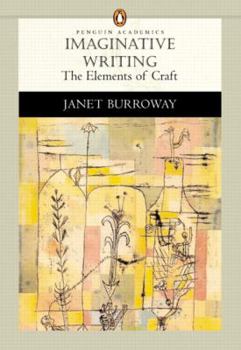Imaginative Writing: The Elements of Craft (Penguin Academics Series)
Select Format
Select Condition 
Book Overview
ALERT: Before you purchase, check with your instructor or review your course syllabus to ensure that you select the correct ISBN. Several versions of Pearson's MyLab & Mastering products exist for... This description may be from another edition of this product.
Format:Paperback
Language:English
ISBN:0321081919
ISBN13:9780321081919
Release Date:August 2002
Publisher:Longman Publishing Group
Length:448 Pages
Weight:1.23 lbs.
Dimensions:0.8" x 6.3" x 9.3"
Customer Reviews
6 ratings
Like reading an organic chemistry text book.
Published by Xavier , 1 year ago
While the overall content is useful, the instruction itself is stiff and burdensome. The examples are, in general, needlessly long and tiresome to make simple points, obviously geared to keep college freshmen busy for a semester. Perhaps my expectations were too high, but having read extensively seminal volumes on writing craft (McKee, Clark, Saunders, James Wood, etc.), I found "Imaginative Writing: The Elements of Craft" dull and dusty and surprisingly lacking in Imagination.
good for school textbook.
Published by Thriftbooks.com User , 15 years ago
this is a good book to be used for a creative wrting class. we use it as reference.had excellent poems and short stories.
Helpful Book For The Begining Writer
Published by Thriftbooks.com User , 16 years ago
A helpful book for the begining writer. I got this book for a class but ended up keeping and using it outside of class as well.
The THIRD Edition of the Classic Intro to Creative Writing
Published by Thriftbooks.com User , 17 years ago
Addendum (1 Feb 2010): As expected Janet Burroway's Imaginative Writing: The Elements of Craft (3rd Edition) adds several new short stories, nonfictions, poems, dramas in place of the ones in the second edition, keeping the overall page count of the book about the same. Notably enhanced are the chapters on drama and on poetry. The drama section cites several examples of a newly popular genre, the ten-minute play. Although intended as a textbook for Creative Writing 101, this book is the best primer for self-teaching or for preparing to enroll in a beyond-basics workshop. ----------------- Unlike the reviews to date, my review focuses on the second edition. The overall organization of the book is unchanged. The first part comprises chapters on the five elements of craft common to all genres of imaginative writing: Image; Voice; Character; Setting; Story. The second part comprises chapters on the four genres: Creative Nonfiction; Fiction; Poetry; Drama. Among the new examples in the second edition are the following: contemporary short stories such as Jhumpa Lahiri's "Interpreter of Maladies," William Trevor's "Sitting with the Dead," Ron Carlson's "Big foot Stole My Wife"; contemporary poems by Billy Collins, Annie Tibble, and Henry Reed: contemporary creative nonfiction by Gayle Pemberton, Bill Capossere, and William Kittredge; contemporary drama by Carol Real, Jim Quinn, and Josh ben Friedman. Also new are a series of development, located in the basic techniques section at the end of each chapter. This series is designed to facilitate readers "toward a finished piece." Burroway has wisely retained many of the exemplary selections from the first edition such as Charles Baxter's "Snow," Donald Barthelme's "The School, and Robert Olen Butler's "Missing." Its unique mutligenre approach, lucid expositions, and "Try This" prompts make IMAGINATIVE WRITING the best primer for teaching yourself. -- C J Singh
An excellent book for the writing classroom
Published by Thriftbooks.com User , 20 years ago
I couldn't disagree more with the one-star review below. I find this such a useful and helpful multi-genre book that I have adopted it for use in my creative writing class here at the University of Alabama. Just an excellent book!
Fresh?
Published by Thriftbooks.com User , 21 years ago
Not to start a war here, but Janet Burroway's book *is* fresh, and it's the best, most comprehensive multigenre text on the market. And it's affordable both for university students and writers who want to use it on their own. No, it's not full of inspirational gobbledygook and gimmicky suggestions to touch the heart of the writer. Instead, it's a very smart book that asks the writer to join in the long histories of the genres it discusses and offers the most succinctly articulated descriptions of techniques and approaches that will not only get a writer started writing but that will also help that writer understand what makes good writing good. The most innovative aspect of Burroway's book is that it takes creative writing as a whole and discusses those basic elements that make all writing good, from the need for concrete imagery that says something to the need for narrative to move and develop across a work. And it offers dozens and dozens of recent examples to illustrate its points. As an anthology alone, this book would be a good read. But Burroway's comments very aptly help a reader to understand what is working well in each of her excerpts. No, it doesn't offer up elaborate metaphors about bones or light or any inner writing child as a way to nurture the soul of the writer. But from my experience as a writing instructor, it's not the soul of the beginning writer that needs nurturing. This book understands quite well the need to nurture the mind of the writer first.






